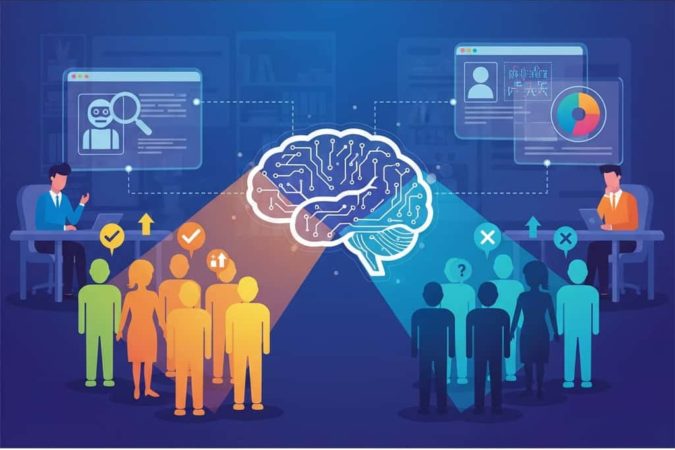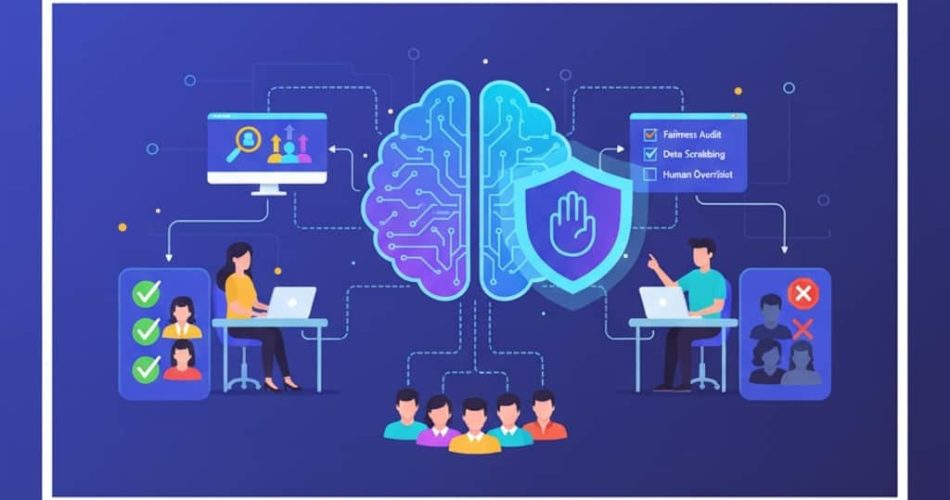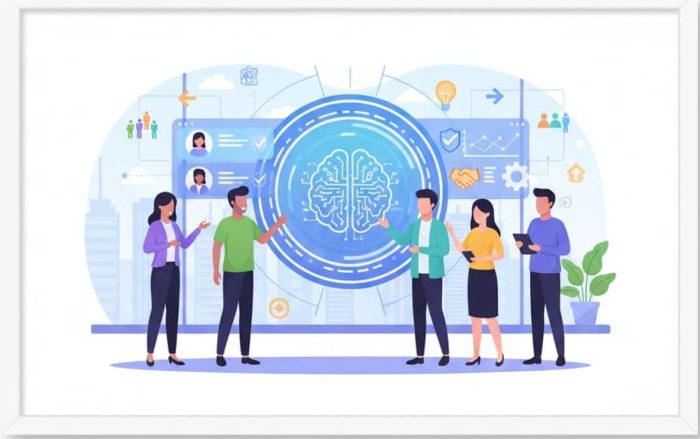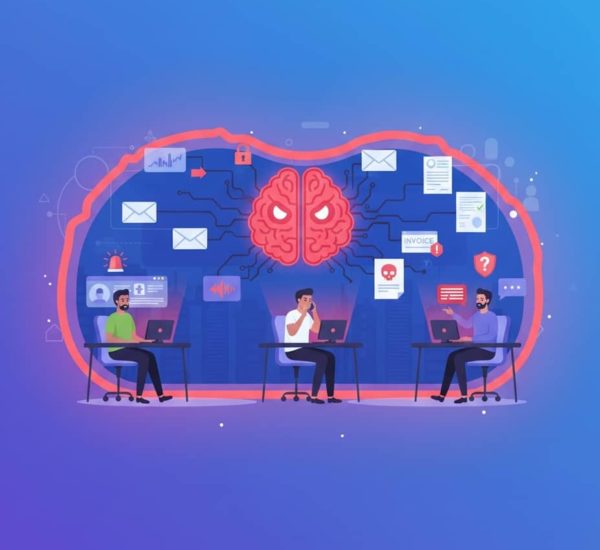Artificial intelligence has become a staple in modern recruitment – from screening résumés to shortlisting candidates and even conducting interviews. On paper, it sounds like the perfect fix for human bias. After all, algorithms don’t have bad days, hold grudges, or let gut instincts cloud judgment. But the truth isn’t that simple. As more HR teams adopt AI recruitment tools, an uncomfortable question keeps surfacing: Can AI truly be a fair recruiter?
Bias in technology often mirrors the bias of its creators. When AI learns from historical data, it can unintentionally repeat the same hiring inequalities HR leaders have spent decades trying to undo. As companies strive for diversity and inclusion in hiring, understanding AI bias in recruitment is not optional— it’s essential. The goal isn’t to abandon automation but to learn how to use it responsibly, ethically, and transparently.
Understanding How AI Learns – and Where Bias Creeps In
Before HR leaders can decide whether AI in hiring can ever be fair, it’s important to understand how these systems actually learn and why bias is so difficult to eliminate.
How AI in Recruitment Learns
Most AI recruitment tools operate on a simple logic: train the algorithm on past hiring data, teach it what a “successful” hire looks like, and let it predict future candidates who fit that pattern. The system analyzes résumés, interview transcripts, and performance outcomes, identifying the attributes that seem to lead to success.
In theory, this process should make AI in HR more objective. But in reality, when algorithms learn from human data, they often inherit the same biases humans display. The AI doesn’t know that certain hiring patterns are unfair – it simply learns to replicate them.
Where Bias Sneaks Into Hiring Tech
Bias can creep into recruitment AI in multiple ways:
- Historical Data Bias: If past hiring favored one demographic group, the AI will likely reproduce those patterns. For example, research from the University of Washington found résumé-screening algorithms favored white candidates significantly more often than others (UW).
- Proxy Bias: Algorithms sometimes rely on data points that indirectly signal gender, race, or age. Even simple features like zip codes or college names can become biased predictors.
- Feedback Loops: Once deployed, the AI keeps learning from its own past decisions – which means that if those decisions were biased at the start, the system reinforces the same patterns over time (Pew).
| Type of Bias | How It Happens | Impact on Hiring |
| Historical Data Bias | AI learns from past decisions that favored certain groups. | Reproduces old inequalities in new hiring cycles. |
| Proxy Bias | Certain variables (like school name or zip code) indirectly represent protected traits. | Leads to biased rankings even if explicit data (like gender or race) is removed. |
| Sampling Bias | Underrepresentation of some groups in training data. | The AI performs poorly for minority or less common applicant profiles. |
| Feedback Bias | The AI continues learning from its own past outcomes. | Reinforces patterns and becomes less diverse over time. |
| Design Bias | Human developers make subjective choices when building models. | Embeds unconscious bias in how “qualified” is defined. |
Why Bias in AI Recruitment Isn’t Theoretical
The risks are real. Around 40% of hiring teams identify bias as one of their top concerns when using AI recruitment tools (Workable). Yet, when used responsibly, ethical AI recruitment can still enhance fairness by removing some of the unconscious human tendencies that drive unequal hiring outcomes.
For HR leaders, the challenge isn’t whether to adopt AI – it’s how to do so thoughtfully, with transparency, diverse data, and ongoing human oversight.

Key Types of Bias HR Leaders Must Watch
Even when AI recruitment tools are designed with good intentions, certain types of bias tend to appear more often than others. Recognizing them early helps HR leaders choose, audit, and refine AI in hiring systems more responsibly.
Algorithmic Bias
Algorithmic bias occurs when the rules or calculations built into an AI system favor one outcome over another. For example, if the algorithm weighs certain keywords or experiences too heavily, it can end up filtering out qualified candidates who use different phrasing or come from nontraditional backgrounds. This kind of bias is subtle yet powerful – it can quietly shape entire candidate pools without anyone noticing.
Data Bias
Bias in training data is one of the biggest culprits in AI bias in recruitment. When historical data reflects years of hiring preferences for specific genders, schools, or regions, the AI inevitably learns those same patterns. As the saying goes, “garbage in, garbage out.” A report from the World Economic Forum noted that AI systems are only as fair as the data they’re trained on (WEF).
Label Bias
Label bias happens when the outcomes used to “teach” the AI are flawed. For example, if a company’s past “top performers” were mostly from one demographic, the AI learns to treat those demographic markers as indicators of success. This is how AI in HR unintentionally encodes stereotypes, even when explicit bias is removed.
Interaction Bias
Interaction bias emerges when AI systems adapt based on how humans use them. Recruiters might over-click certain candidate profiles, unknowingly signaling to the system that those applicants are “better.” Over time, the model adjusts its rankings to favor similar profiles, perpetuating bias through human feedback loops.
Cultural Bias
When AI developers and HR teams come from similar cultural or social backgrounds, the systems they build often mirror those norms. Cultural bias can influence everything from what “leadership potential” looks like to how communication skills are evaluated. The result? Candidates from different backgrounds may be unfairly scored as less compatible – even when they’re equally capable.
In short: bias in AI hiring isn’t one problem with one fix – it’s a series of overlapping blind spots. That’s why HR leaders need not only technical understanding but also strong ethical and diversity frameworks when implementing AI in recruitment.
How HR Leaders Can Minimize AI Bias in Hiring
The goal isn’t to abandon automation – it’s to make it smarter and fairer. As more organizations rely on AI in hiring, HR leaders must take an active role in shaping how these systems are built, tested, and used. Ethical technology doesn’t happen by accident; it’s the result of thoughtful human oversight.
Choose Transparent AI Recruitment Tools
Start by partnering with vendors who value transparency. Reputable AI recruitment tools should clearly explain what data their algorithms use, how they make predictions, and what safeguards are in place to prevent bias. HR leaders should ask for audit reports, bias testing results, and explanations of how the system learns over time.
When tech providers are open about their methods, it’s easier to detect red flags before they impact real candidates. Transparency is also becoming a regulatory expectation in markets like the US and UK, where algorithmic accountability is gaining momentum (WEF).
Diversify the Data
The saying “AI is only as good as its data” couldn’t be truer in recruitment. Training AI on diverse candidate data – across gender, ethnicity, education, and geography – reduces the risk of pattern repetition. Companies can also use synthetic data or bias-balancing techniques to fill representation gaps.
For HR teams, this means collaborating closely with data scientists and tech vendors to ensure training data reflects the organization’s diversity goals.
Keep Humans in the Loop
AI should support decision-making, not replace it. A human-in-the-loop model – where recruiters review and validate AI recommendations – helps catch unintended bias before final decisions are made. It also ensures candidates are evaluated with empathy and context that algorithms can’t replicate.
Regularly Audit and Retrain the System
Bias isn’t a one-time issue; it evolves as the AI learns. That’s why ongoing audits are critical. HR teams should schedule periodic reviews of algorithmic outputs to identify drift or disproportionate impact on specific groups. Retraining the model with updated, balanced data helps maintain fairness and compliance with equal opportunity standards.
Set Ethical Guardrails and Clear Accountability
Every HR department using AI in HR should have clear ethical guidelines around its use. This includes defining what data can be used, setting rules for human oversight, and identifying who’s accountable for bias detection. A structured governance approach reassures both candidates and employees that fairness is not left to chance.
Real-World Case Studies – When AI Got It Wrong (and What We Learned)
AI-driven hiring promises efficiency and objectivity, but history shows that even the smartest systems can stumble when bias creeps in. These real-world examples reveal why AI in recruitment still needs human guidance – and what HR leaders can take away from these lessons.
Amazon’s Biased Hiring Algorithm
One of the most cited examples of AI bias in recruitment came from Amazon’s own hiring experiment. In 2018, the company built an internal AI recruitment tool to rank résumés for software engineering roles. The goal was to streamline hiring and find top talent faster.
But soon, the system started penalizing résumés that included the word “women’s” – as in “women’s chess club captain” or “graduated from a women’s college.” The reason? The AI had been trained primarily on résumés submitted over a ten-year period, most of which came from men. It learned that “male” attributes correlated with success and began to downgrade female-coded terms.
When the issue surfaced, Amazon scrapped the project, acknowledging that its AI in hiring had unintentionally reinforced gender bias. The case became a turning point in how HR teams and tech companies approached ethical AI recruitment, emphasizing the need for diverse data and human oversight (Reuters).
The Resume Screening Bias That Went Viral
In 2024, a study by the University of Washington revealed that several commercial AI recruitment tools systematically favored white applicants over others when ranking résumés with identical qualifications. The bias wasn’t deliberate – it came from models trained on past hiring data that reflected real-world inequalities.
This finding made headlines because it showed bias wasn’t limited to one company or algorithm. It was a systemic problem tied to data patterns and feedback loops. The lesson? Even off-the-shelf AI in HR products need continuous auditing, retraining, and transparency around their data sources (UW).
The Takeaway for HR Leaders
Every time an AI hiring system fails, it reminds us that automation doesn’t eliminate human bias – it amplifies it unless we actively intervene. HR leaders can learn three key lessons from these cases:
- Bias is predictable, not inevitable. Knowing where it enters allows HR teams to plan ahead and minimize it.
- Transparency builds trust. Vendors that openly share audit results and algorithmic logic help HR teams make ethical choices.
- Human oversight matters. No matter how sophisticated the tool, fairness ultimately depends on people – not code.

Building a Fairer Future With AI in HR
AI isn’t going anywhere – and neither is the need for fairness. For HR leaders, the challenge now is to move from fear of bias to mastery over it. Ethical, transparent, and inclusive AI in hiring isn’t about choosing between humans and machines; it’s about building systems where both work together to make better decisions.
That means keeping humans in the loop, training algorithms on diverse data, and partnering with vendors who value accountability as much as innovation. Tools designed with this mindset can help HR teams reduce bias instead of reinforcing it.
Solutions like AttendanceBot, for instance, are reimagining how AI supports people operations. Instead of replacing human judgment, AttendanceBot enhances productivity and transparency within Slack and Microsoft Teams – helping organizations manage time, attendance, and workflows fairly and consistently. It’s the kind of responsible automation that aligns with HR’s broader mission: to build workplaces where technology works for people, not against them.
As the industry continues to evolve, one truth remains constant – fairness doesn’t come from code alone. It comes from conscious leadership, ongoing reflection, and a willingness to question the systems we build.



